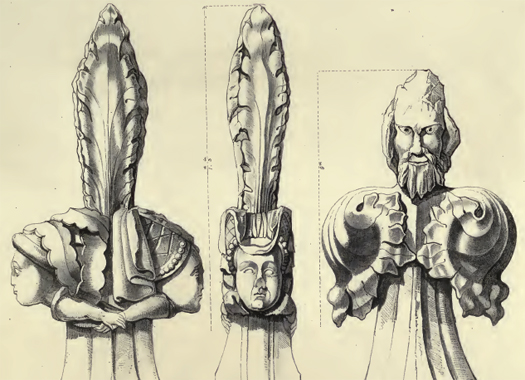1. Keiichi Matsuda‘s “Domestic Robocop” offers a glimpse of an augmented future which is part bliss and part nightmare:
Matsuda’s video is via BLDGBLOG, Serial Consign, @doingitwrong, and more or less everyone else.
2. In BLDGBLOG‘s brief entry on Matsuda’s video, he suggests that “augmented-reality drop-down menus are the Gothic ornamentation of tomorrow”; if that suggestion intrigues you, read Christopher Hawthorne on digital ornamentation.
3. And then, shifting in topic from display on architecture to display of architecture, Geoff Manaugh reviews “Museum of the Phantom City” in iconeye; obviously, it gets speculative.
4. Wired, on the next industrial revolution:
Today, micro-factories make everything from cars to bike components to bespoke furniture in any design you can imagine. The collective potential of a million garage tinkerers is about to be unleashed on the global markets, as ideas go straight into production, no financing or tooling required. “Three guys with laptops” used to describe a Web startup. Now it describes a hardware company, too…
The academic way to put this is that global supply chains have become scale-free, able to serve the small as well as the large, the garage inventor and Sony. This change is driven by two forces. First, the explosion in cheap and powerful prototyping tools, which have become easier to use by non-engineers. And second, the economic crisis has triggered an extraordinary shift in the business practices of (mostly) Chinese factories, which have become increasingly flexible, Web-centric, and open to custom work (where the volumes are lower but the margins higher).
The article frames this transition roughly as “watch manufacturing become more like the internet”, but I’m at least as interested in the new physical geographies generated by this shift (the “shanzhai” factories, for instance, as architectural manifestations of evolving global supply chains) as I am in the impressive virtuality of it all.

5. The City Project fires a broadside at architects and associated urbanists for obsessing over the potential of the digital city to the exclusion of political and “embodied” concerns. While I think the piece perhaps overstates the degree to which urbanists are exclusively interested in the digital and the networked, I agree that the issue of access which The City Project raises ought to be given great weight in any discussion of the digital city. Perhaps it is worth remembering that Gothic ornamentation was no marker of great social equality.
6. Finally, as one example of engagement between social aims for architecture (in particular, environmental justice) and the potential of the digital city, “Local Code: Real Estates”, which was one of the finalists in the WPA 2.0 competition:
“Local Code” engages urban systems digitally at both a macro level, through the deployment of GIS modeling to locate abandoned and unclaimed urban spaces, and at a micro level, as individual spaces are plugged into a model of the larger needs of the city and redesigned accordingly. The project was recently profiled by Allison Arieff for the New York Times:
…Using G.I.S. in conjunction with parametric design tools, Local Code suggests a set of individual landscapes for each site with the goal of mitigating larger urban performance variables like storm-water retention and heat-island effects — referring to the 1.8 to 5.4 degrees Fahrenheit temperature increase that occurs within densely built environments. (De Monchaux suggests that his intervention would most likely render redundant San Francisco’s current multi-billion dollar effort at increasing sewer storm-water capacity). Together, the aggregated sites project an alternative green infrastructure with potentially measurable benefits to safety and public health as well.
Looking through this lens also enables us to think about infrastructure in a new way. The era of massive, expensive, centralized projects like the Big Dig in Boston has passed. “Now, with the ability to model dynamic systems, we can show a much more decentralized collection of resources could provide greater benefit,” de Monchaux says. “If, in the 19th century, it was a biological metaphor that fueled the creation of Central and Golden Gate parks, the idea that a city needs hearts and lungs to grow, there’s now a networked metaphor. The city is a dense network of relationships. The best way to provide infrastructure is to not go in with a meat ax but to practice urban acupuncture, finding thousands of different spots to go into.”


While not atypical for a variety of people, i thought this post’s take on Keiichi Matsuda’s “Domestic Robocop” proposal might be of interest.
Entitled INCOMING REALITY: WATCH IT AND WEEP
http://www.arthurmag.com/2010/02/04/incoming-reality/
hey becker
wow this guy is nuts, all of his vids are pretty quality… http://vimeo.com/4929345 i love the sketch montage here.
i know my thesis is going to explore digital space and ways to leverage it.
thanks
Scott! I hear you’re milking cpSLO for all it’s worth. Mike Lucas said your portfolio was impressive, and that you’re schooling all the 5th years on grasshoppa. Nice work brother.
[…] “Augmented City”. Matsuda (whose previous video, “Domestic Robocop”, we noted at beginning of the year) produced the short for his Masters Thesis at the Bartlett School of […]